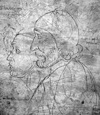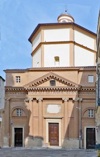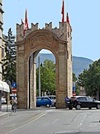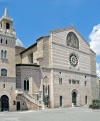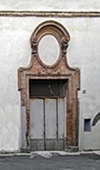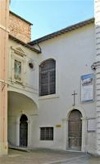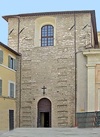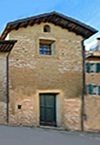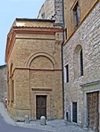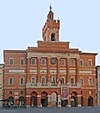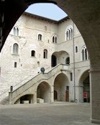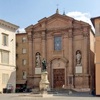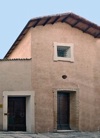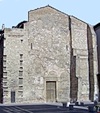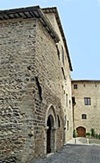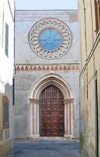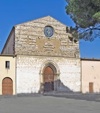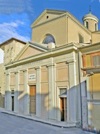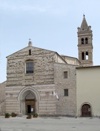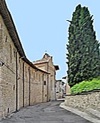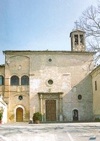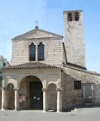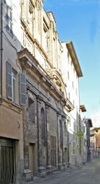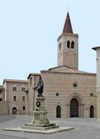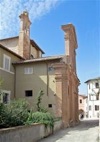Abbazia di Santa Croce di Sassovivo (11th century)
Bridges of Foligno
Casa di Nicolò Alunno (15th century)
Chiesa del Suffragio (1724-45)
City Walls and Gates
Duomo of San Feliciano (begun in 1133)
Nunneries in Via dei Monasteri
-
✴Santa Maria del Popolo;
-
✴Sant’ Elisabetta;
-
✴Sant’ Agnese (the portal of which is illustrated here); and
-
✴Santa Maria di Betlem.
Oratorio del Crocifisso (1587-1702)
Oratorio del Gonfalone (1725-38)
Oratorio della Misericordia (17th century)
-
✴their church of San Giovanni Decollato, which was demolished in 1869; and
-
✴the oratory (illustrated here) that they built on the site to which they moved in 1569.
Oratorio della Nunziatella (1494)
Ospedale Vecchio di San Giovanni Battista (1517-20)
-
✴the old hospital of Foligno, in Corso Cavour; and
-
✴its church, San Giovanni Battista, which was demolished in 1873-4.
Palazzo dei Canonici (1923-6)
Public Palaces of Foligno
-
✴Palazzo Comunale (1546-1642), remodelled after the earthquake of 1832 (illustrated here);
-
✴Palazzo Orfini (1515);
-
✴ex-Palazzo Comunale (1262-5); and
-
✴the so-called Palazzetto del Podestà (13th century)
Palazzo Trinci (1389-1411)
Patrician Palaces of Foligno
-
✴three palaces in Walk I:
-
•Palazzo Varini (15th century), illustrated here;
-
•Palazzo Gregori (16th century);
-
•Palazzo Piermarini (early 19th century); and
-
•Palazzo Elisei;
-
•Palazzo Giusti Orfini; and
-
✴the following palaces in Walk II:
-
•Palazzo Nuti Deli (1510-6);
-
•Palazzo Cibo Nocchi (1497);
-
•Casa degli Atti (14th century);
-
•Palazzo Gentili Spinola (16th century);
-
•Palazzo Brunetti Candiotti (1781);
-
•the four palaces in the Insula dei Vitelleschi:
-
-Palazzo Vitelleschi;
-
-Palazzo Prosperi Valenti;
-
-Palazzo Vallati Montogli; and
-
-Palazzo Gigli; and
-
•three palaces in Piazza XX Settembre:
-
-Palazzo Monaldi Barnabò (1620-8) ;
-
-Palazzo Jacobilli Carrara (ca. 1565); and
-
-Palazzo Barnabò alle Conce (ca. 1510)
Sant’ Agostino (1720-50)
Sant’ Anna (ca. 1390)
Sant’ Apollinare (6th century ?)
San Bartolomeo di Marano (1731-6)
Ospedale della Trinità (1374), now Monastero di Santa Caterina Nuova
Santa Caterina Vecchia, or delle Vergine (14th century)
San Claudio (1229)
Text
San Domenico (1285 - ca. 1474)
San Feliciano di Mormonzone (14th century)
San Francesco (1796-1856)
San Giacomo (1402)
San Giovanni Battista (12th century)
-
✴the ancient parish church of San Giovanni Battista, which passed to a community of hermits of St Jerome in 1493 (remodelled in 1719-20); and
-
✴the Ospedale Civile (1845-60), which was built on the site of their adjacent monastery.
San Giovanni Profiamma (11th century)
Santa Lucia (1928)
Santa Maria di Betlem (1379)
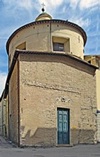
-
✴the Monastero di Santa Maria di Betlem; and
-
✴the nuns’ new church, the Chiesa del Corpo di Cristo (1672-1740), illustrated here.
Santa Maria in Campis (12th century)
Santa Maria Giacobbe (13th century)
Santa Maria Infraportas (ca. 1100)
Santa Maria di Plestia
San Nicolò (ca. 1348)
San Pietro in Pusterna (12th century ?) and San Carlo (1613-23)
-
✴the ancient church of San Pietro in Pusterna, which contains the earliest frescoes that survive in Foligno; and
-
✴the Barnabite complex of San Carlo, which includes the church of San Carlo (illustrated here) and which incorporated San Pietro in Pusterna in 1614.
San Salvatore (14th century)
SS Trinita in Annunziatà (1755)
-
✴the two nunneries belonging to Franciscan tertiaries that merged in 1755;
-
•the Monastero di SS Annunciata (1347); and
-
•the Monastero di SS Trinità (1372); and
-
✴the nuns’ new church of SS Trinità in Annunziata (1760-75), illustrated here.
Small Churches
-
✴three churches that no longer survive:
-
•Santa Maria della Croce (1286);
-
•San Leonardo (12th century) ; and
-
•Santa Maria Maddalena (13th century);
-
✴Santa Maria della Consolazione;
-
✴San Tommaso dei Cipischi (1190);
-
✴San Giovanni dell’ Acqua (13th century);
-
✴the Oratorio del Buon Gesù (1561), of which only vestiges survive;
-
✴Santa Margherita alle Conce (1722-33), illustrated here; and
-
✴Santa Maria delle Grazie (1898).
Return to the home page on Foligno.




